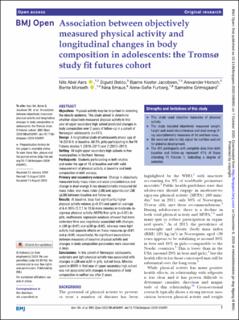| dc.contributor.author | Aars, Nils Abel | |
| dc.contributor.author | Beldo, Sigurd | |
| dc.contributor.author | Jacobsen, Bjarne K. | |
| dc.contributor.author | Horsch, Alexander | |
| dc.contributor.author | Morseth, Bente | |
| dc.contributor.author | Emaus, Nina | |
| dc.contributor.author | Furberg, Anne-Sofie | |
| dc.contributor.author | Grimsgaard, Sameline | |
| dc.date.accessioned | 2022-11-16T10:25:14Z | |
| dc.date.available | 2022-11-16T10:25:14Z | |
| dc.date.created | 2020-10-27T17:52:54Z | |
| dc.date.issued | 2020 | |
| dc.identifier.citation | BMJ Open, 2020, 10 (10), 1-9 | en_US |
| dc.identifier.issn | 2044-6055 | |
| dc.identifier.uri | https://hdl.handle.net/11250/3032123 | |
| dc.description.abstract | Objectives Physical activity may be important in deterring the obesity epidemic. This study aimed to determine whether objectively measured physical activity in first year of upper secondary high school predicted changes in body composition over 2 years of follow-up in a cohort of Norwegian adolescents (n=431).
Design A longitudinal study of adolescents (mean age of 16 (SD 0.4) at baseline, 60.3% girls) participating in the Fit Futures studies 1 (2010–2011) and 2 (2012–2013).
Setting All eight upper secondary high schools in two municipalities in Northern Norway.
Participants Students participating in both studies and under the age of 18 at baseline and with valid measurement of physical activity at baseline and body composition in both surveys.
Primary and secondary outcomes Change in objectively measured body mass index and waist circumference and change in dual-energy X-ray absorptiometry measured fat mass index, lean mass index (LMI) and appendicular LMI (aLMI) between baseline and follow-up.
Results At baseline, boys had significantly higher physical activity volume (p=0.01) and spent on average of 6.4 (95% CI 2.1 to 10.6) more minutes in moderate-to-vigorous physical activity (MVPA) than girls (p<0.01). In girls, multivariate regression analyses showed that more sedentary time was negatively associated with changes in LMI (p<0.01) and aLMI (p<0.05), whereas more light activity had opposite effects on these measures (p<0.01 and p<0.05, respectively). No significant associations between measures of baseline physical activity and changes in body composition parameters were observed in boys.
Conclusions In this cohort of Norwegian adolescents, sedentary and light physical activity was associated with changes in LMI and aLMI in girls, but not boys. Minutes spent in MVPA in first year of upper secondary high school was not associated with changes in measures of body composition in neither sex after 2 years. | en_US |
| dc.language.iso | eng | en_US |
| dc.rights | Navngivelse-Ikkekommersiell 4.0 Internasjonal | * |
| dc.rights.uri | http://creativecommons.org/licenses/by-nc/4.0/deed.no | * |
| dc.title | Association between objectively measured physical activity and longitudinal changes in body composition in adolescents : the Tromsø study fit futures cohort | en_US |
| dc.type | Peer reviewed | en_US |
| dc.type | Journal article | en_US |
| dc.description.version | publishedVersion | en_US |
| dc.source.pagenumber | 1-9 | en_US |
| dc.source.volume | 10 | en_US |
| dc.source.journal | BMJ Open | en_US |
| dc.source.issue | 10 | en_US |
| dc.identifier.doi | 10.1136/bmjopen-2020-036991 | |
| dc.identifier.cristin | 1842707 | |
| dc.source.articlenumber | e036991 | en_US |
| cristin.ispublished | true | |
| cristin.fulltext | original | |
| cristin.qualitycode | 1 | |

